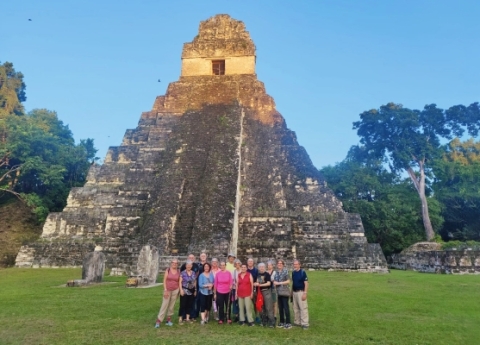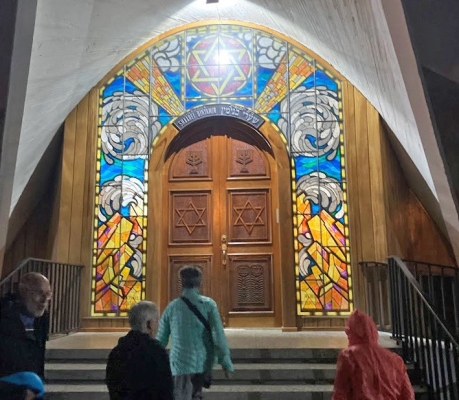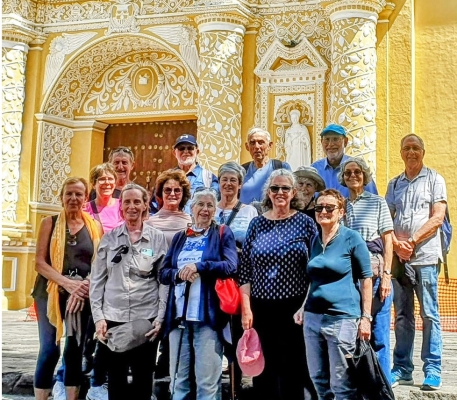An Israeli Book Club Explores Guatemala
By Sally Esakov and Frankie Cronin
Once upon a time in 1979, a group of British, Canadian and American women who lived in Herzliya and Raanana formed a book club to read and discuss one book on the first Monday of each month. We served tea, coffee and nibbles, met after the youngsters went to bed, and after "Fame" ended.
Lo and behold, the book club still meets the first Monday each month, still reads and discusses one book, but the nibbles have evolved into a full dairy meal served with wine. So, how did we end up visiting Guatemala?
Frida, one of our long time members, was born in Guatemala to WWII survivor parents who endured harrowing experiences in Europe, traveled independently to Guatemala after the war, met and made a new life for themselves in a new land. For several years, she had wanted to show us her childhood home and display the wonders of Guatemala. So with the help of a local tour facilitator, last November we embarked on a magical tour of Guatemala in a mixed group of married couples and singles. This article will describe a few highlights of our trip.
Magical Mystery Tour
We flew into Guatemala City, and began with an annoying two-hour experience at the bank to exchange USD into quezalas, because the clerk checked everything multiple times.
Our first, very comfortable hotel had thick towels, bathrobes, amenities and meals offered in the executive lounge. We rested up from the long flight from Israel [typically a total of 19 hours with an intermediate stopover], before walking to Friday night services at the Ashkenazi Shul Shaarei Binyamin / Centro Hebreo that Frida's father (Joseph Engelberg) helped found. The synagogue is on a main street, hidden behind an outer wall. We passed through a metal barrier, our passports were checked against a list by security guards, and we entered the shul grounds via two more security doors.
The shul was decorated with beautiful stained-glass windows and mehitza between the men and women's section. Mike Cronin led the davening. We joined the community dinner, organized in our honor in the basement recreation room.
Guatemala City, with a nominal population of ~ 1,200,000, has become a magnet for people from outlying villages who come to work in the city. To be in the office at 8 am, they must catch the extravagantly painted "chicken" bus as early as 4am. There are no trains due to the mountainous landscape, and the roads are mainly two lanes with speed bumps going through each village, and often under construction, because the tropical rains wash away sections of the road.
In the countryside, villagers can easily grow crops, chickens and pigs due to the volcanic soil and the abundant rain which provides ideal growing conditions. There are corn fields on every spare plot.
After a short journey on our minibus, we were hosted at the family house on Lake Atitlan, whose water was once potable, but is now contaminated by factory runoff. Frida introduced us to fruits and vegetables that are indigenous to Guatemala. We were entertained by a five-man mariachi band in full costume.
We explored the famous market in a colorful Mayan village, Chichicastenango, and visited the church in the center of the village. The religion is a combination of Catholic and Mayan traditions; shamans purify its stairs with incense and flowers, and indulge in Mayan rituals. The Kaqchikel Indians descend from the surrounding villages twice a week to sell their wares in the market, and the city transforms into a kaleidoscope of colors and smells. The women wear the traditional huipil representing the seasons of the Mayan calendar.
After another journey of a few hours, we arrived at Guatemala's deepest lake, Atitlan, formed in the crater of an extinct volcano and nestled between the mountains at a pleasant 1,500 meters above sea level. We travelled by speedboat to three different villages around the lake, where we visited a coffee plantation, a chocolate outlet and a women's collective, where they demonstrated how to extract the seeds from the cotton ball, wind the cotton balls into thread, dye it with bark, leaves and vegetables, and weave it on a loom attached to the woman's waist.
We spent an amazing two days in Antigua, the capital of the Spanish Conquistadors from 1543. Following several devastating earthquakes, the capital was moved to Guatemala City in 1773. However, the city, now a UNESCO Heritage Site, has been restored to all its Spanish Baroque-style splendor, and is a vibrant tourist attraction.
Then back to Guatemala City Airport for our 50-minute flight northwards to Flores, surrounded by the hot steamy jungle. Our lakeside hotel, built by one of Guatemala's magnates, was the height of luxury, and we took a boat trip to see the spider monkeys, specially brought to a nearby island Nature Reserve.
From there we traveled along bumpy two-lane roads to reach the first of three impressive archaeological sites to learn more about the Mayan civilization. Our guide wanted us to arrive at sunset to appreciate the huge pyramids in the impressive city of Tikal that were constructed around 2000 years ago. This entailed a mad rush along jungle paths to reach the archaeological site in time. Those of us who were able to climb the 200 wooden steps to the top of Temple IV (Serpent Temple) at 65 meters were wowed with the amazing sight of other temples poking out above the tree line.
We also visited two other sites, each with their own unique features. Yaxha was founded in 800 BC and was home to 40,000 people at its peak in 250 AD. As well as nine huge temples, they have discovered ball courts, and wide causeways to connect the various parts of the city. Quirigua is famous for its carved stelae and calendars which can now be deciphered to help understand the Mayan culture.
After driving for over four hours, we arrived at the tropical River Dulce on the Caribbean coast. A boat ride down a jungle-lined canyon with limestone cliffs led us to the village of Livingston where most of the population are the Garifuna, descendants of black slaves, with their own culture and language.
Interestingly, two of our several guides claimed Jewish parentage, and we met a Brazilian tourist who had received Portuguese citizenship based on her family's ancestry of fleeing Portugal 500 years previously. Many of the ordinary citizens that we met expressed support for Israel and some vendors displayed Israeli flags.
We learnt about the unstable politics of Guatemala, the corruption at high levels, and the gangs who terrorize the local population, resulting in neighborhood stores protected by metal bars and gun-toting guards. We enjoyed the plethora of exotic fruits and tropical flowers, including shrubs growing in Israel, only in Guatemala they were more lush and more colorful.
We visited areas of natural beauty and awe, and even witnessed an actively smoking volcano (which erupted two weeks after our holiday).
We even held our monthly book club meeting, including the husbands with a book of their choice.
Best of all, we enjoyed each other's company, while seeing many exciting places and sights, and learning about unknown traditions. It was indeed a trip of a lifetime.











Comments